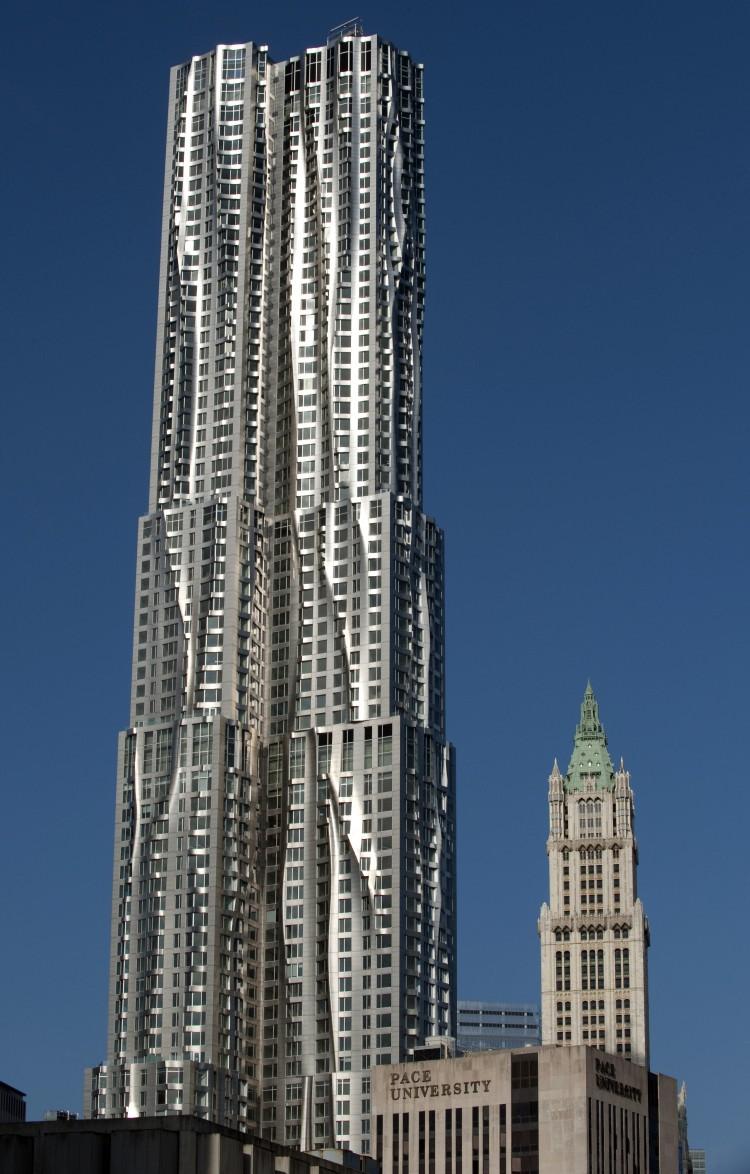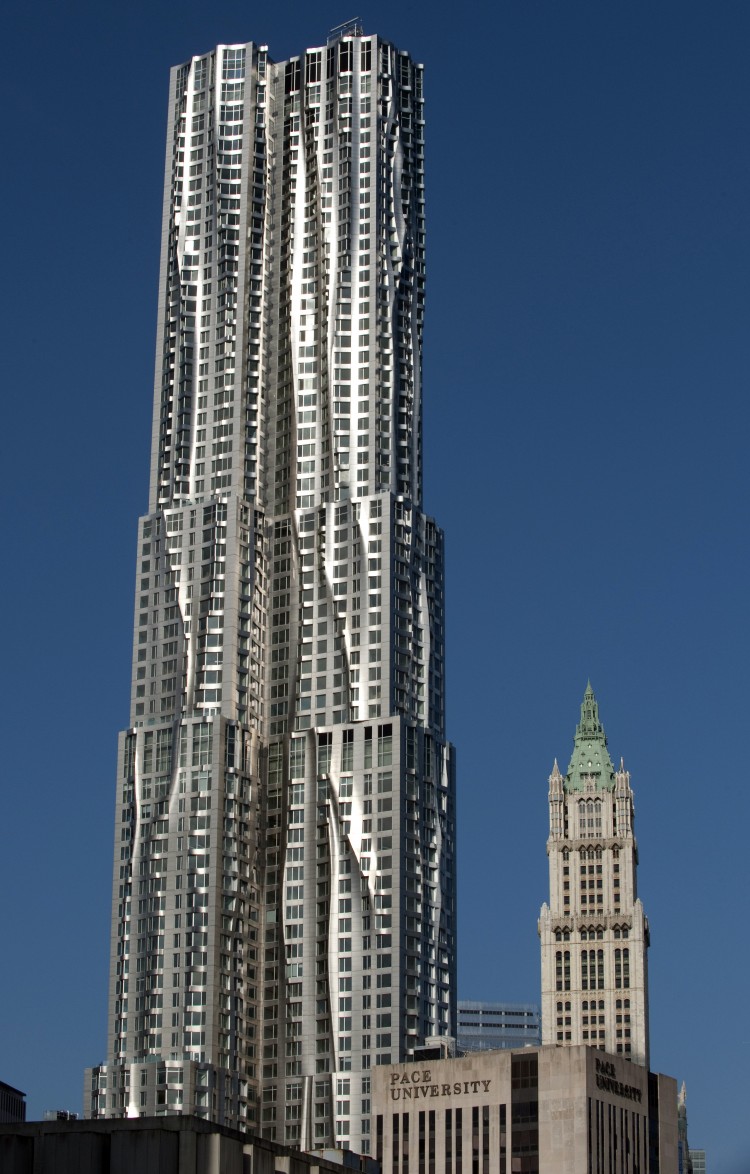NEW YORK—The spire located at 8 Spruce St., which opened its doors in February, is the tallest residential building in the Western Hemisphere.
In what may be the tightest squeeze of usable space in the city, the fluid arches of the building tower over Pace University and the Downtown Hospital, and just blocks away lie City Hall, the Municipal District, NYPD Headquarters, the Brooklyn Bridge, and Mary Bergtraum High School. With the opening of the 9/11 memorial months away, 8 Spruce St.—called New York by Gehry—is representative of the bigger, better, and greener new downtown.
The bottom of the building contains a 100,000-square-foot space dedicated to a public school, a 25,000-square-foot space for the Downtown Hospital, and 903 luxury rental condos.
“We could climb into the heavens and do something extraordinary,” said MaryAnne Gilmartin, describing the aspirations of the design and development team, unrestricted by downtown’s lack of height limitations. Gilmartin is the director of Commercial and Residential Development at Ratner Companies, the developer of the project.
Along with other major players in downtown housing development, she answered questions as part of a panel at The New Downtown Conference, chaired by Larry Silverstein, whose company Silverstein Properties is the current holder of the World Trade Center lease.
The 76-story tower, designed by Canadian architect Frank Gehry, can be seen from across the Brooklyn Bridge. It is currently the sole major downtown development east of Broadway. West of Broadway, meanwhile, a whole new downtown has sprung up over the past decade. Battery Park City is fast becoming the top destination for young families, with sustainable, LEED Gold-certified residential complexes, four new, top-rated public schools, and one of the most developed waterfront areas in the world.
“The number one issue for families that move into lower Manhattan is schools. It is all about schools. We have some of the best public schools in the city in lower Manhattan with P.S. 234 and P.S. 89,” said Julie Menin, chairperson of Community Board 1.
“I would say that we are the only neighborhood in all of the five boroughs that has had three new schools built in the past four years,” she added, in talking about the newly built P.S. 276, the Spruce Street School, and the Peck Slip School.
Community Board 1 and the Alliance for Downtown New York have been the leading organizations to keep New York residents and businesses downtown following the 9/11 catastrophe.
“The Downtown Alliance was actually the first organization out on the street with money to keep retailers alive. There was no federal money in the beginning,” said Carl Weisbrod, the founding president of the Alliance for Downtown New York.
Over 13,000 residents live in Battery Park City, benefiting from more than 3,000 units of housing added over the last decade following 9/11. Overall, more than 30,000 residents have moved into the downtown area south of Canal St. since 9/11.
“We have major parks, playgrounds for children, dog runs, we have something for everyone,” said Gayle M. Horwitz, president and CEO of the Battery Park City Authority.
“The great feature of Battery Park City is that it is a completely green, sustainable community,” she added.
The 9/11 Memorial Plaza is set to open for the 10th anniversary ceremonies. Four to five million people are expected to visit the site annually.
In what may be the tightest squeeze of usable space in the city, the fluid arches of the building tower over Pace University and the Downtown Hospital, and just blocks away lie City Hall, the Municipal District, NYPD Headquarters, the Brooklyn Bridge, and Mary Bergtraum High School. With the opening of the 9/11 memorial months away, 8 Spruce St.—called New York by Gehry—is representative of the bigger, better, and greener new downtown.
The bottom of the building contains a 100,000-square-foot space dedicated to a public school, a 25,000-square-foot space for the Downtown Hospital, and 903 luxury rental condos.
“We could climb into the heavens and do something extraordinary,” said MaryAnne Gilmartin, describing the aspirations of the design and development team, unrestricted by downtown’s lack of height limitations. Gilmartin is the director of Commercial and Residential Development at Ratner Companies, the developer of the project.
Along with other major players in downtown housing development, she answered questions as part of a panel at The New Downtown Conference, chaired by Larry Silverstein, whose company Silverstein Properties is the current holder of the World Trade Center lease.
The 76-story tower, designed by Canadian architect Frank Gehry, can be seen from across the Brooklyn Bridge. It is currently the sole major downtown development east of Broadway. West of Broadway, meanwhile, a whole new downtown has sprung up over the past decade. Battery Park City is fast becoming the top destination for young families, with sustainable, LEED Gold-certified residential complexes, four new, top-rated public schools, and one of the most developed waterfront areas in the world.
“The number one issue for families that move into lower Manhattan is schools. It is all about schools. We have some of the best public schools in the city in lower Manhattan with P.S. 234 and P.S. 89,” said Julie Menin, chairperson of Community Board 1.
“I would say that we are the only neighborhood in all of the five boroughs that has had three new schools built in the past four years,” she added, in talking about the newly built P.S. 276, the Spruce Street School, and the Peck Slip School.
Community Board 1 and the Alliance for Downtown New York have been the leading organizations to keep New York residents and businesses downtown following the 9/11 catastrophe.
“The Downtown Alliance was actually the first organization out on the street with money to keep retailers alive. There was no federal money in the beginning,” said Carl Weisbrod, the founding president of the Alliance for Downtown New York.
Over 13,000 residents live in Battery Park City, benefiting from more than 3,000 units of housing added over the last decade following 9/11. Overall, more than 30,000 residents have moved into the downtown area south of Canal St. since 9/11.
“We have major parks, playgrounds for children, dog runs, we have something for everyone,” said Gayle M. Horwitz, president and CEO of the Battery Park City Authority.
“The great feature of Battery Park City is that it is a completely green, sustainable community,” she added.
The 9/11 Memorial Plaza is set to open for the 10th anniversary ceremonies. Four to five million people are expected to visit the site annually.






